1901 Old Main Fire
- Home
- The College of Wooster
- Exhibits
- 1901 Old Main Fire
By Laura Merrell, revised by Jordan Wilson
The Story of the 1901 Fire and Aftermath
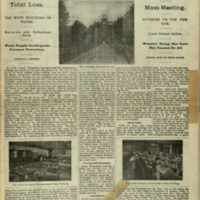
On Wednesday, December 11, 1901, tragedy struck the University of Wooster’s campus. Around 2:45 am, David Gill, a janitor, reported a fire in the main academic building, Old Main, after he heard an explosion. By the time the fire department arrived, the fire continued to burn uncontrollably.1 Students and faculty could only watch helplessly as the walls and ceiling of Old Main collapsed and the fire burned unabated “with a red and horrid glare”.2 The mood turned despondent as students and faculty realized that the fire had destroyed valuable science equipment and Professor Scovel’s unpublished manuscript.
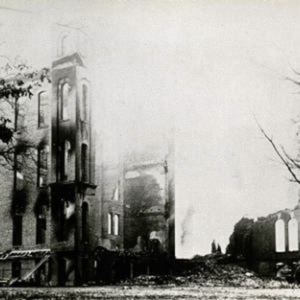
President Holden was out of town when the fire struck, but sent a telegram to the University, stating: “We have lost our building. Let us stand together until we shall rear another”.3 The students, faculty, and community were still reeling from the effects of the fire, but a mission to raise money to rebuild a stronger and larger campus quickly began. Although the cause of the fire was never determined, most believed that an explosion in one of the chemistry labs was responsible.4
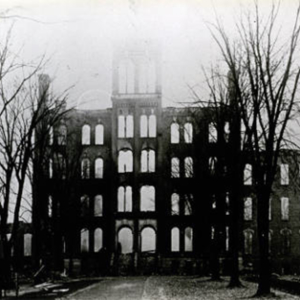
Immediately after the fire, the faculty met in the library to discuss what action needed to be taken, followed by a 10:00 am meeting with the students in the gymnasium. Students sang the college song to keep up morale and the decision was made to finish the academic year only a day late and hold final examinations in the library.
“President of a Hole in the Ground”: President Holden’s Rush to Rebuild
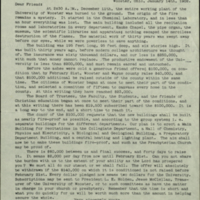
Soon after Old Main burned down, the townspeople, students, faculty, and Wooster’s Board of Trade met to discuss the future. The town quickly came to the University’s aid and loaned them the newly built school in the Second Ward, while the Board of Trade gave the University $15,000.5 Donations started to pour in from alumni of the University, local businesses, such as the Wooster Brush Works, and local churches, such as St. Mary’s.6
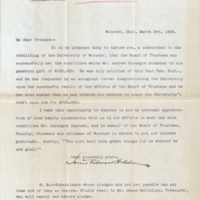
President Holden was away from the University when the fire occurred, but immediately sprang into action when he found out about the incident. He sent fourteen dollars worth of telegrams, worth approximately $400 today, to wealthy businessmen for help.7 Despite a swift and positive initial response, the University still required more money and successful rebuilding remained uncertain until a mysterious benefactor stepped forward with an offer.
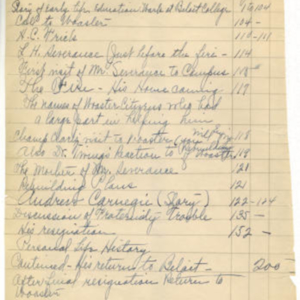
Andrew Carnegie: A Reluctant Hero
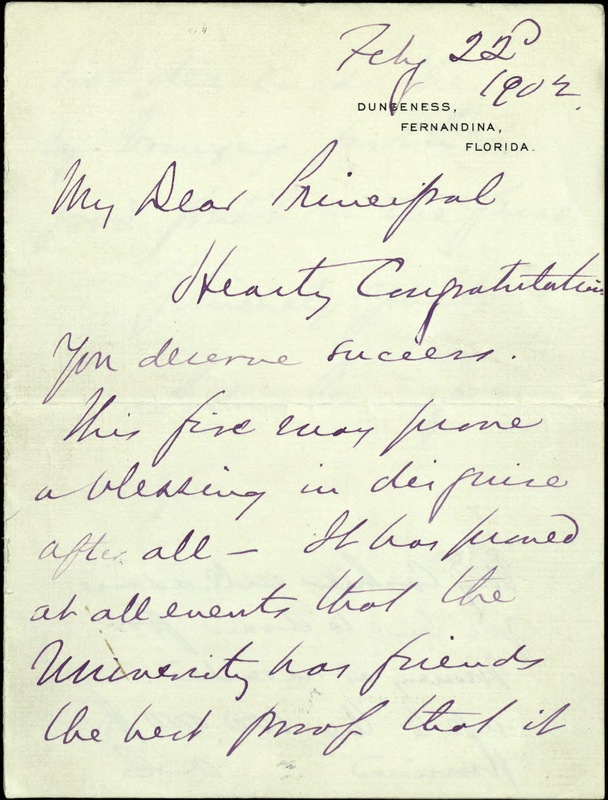
The University of Wooster received a curious, but extremely generous proposal: if the University and town could raise $40,000 in sixty-five days, an unknown benefactor would give $100,000 towards rebuilding efforts.8 On the last day to fulfill the condition, local businesses closed and the town held a jubilee to celebrate getting enough money, although they had also envisioned the event as a last minute fundraiser, if necessary. By working together, the University and town managed to meet the required deadline to acquire the $100,000. This anonymous benefactor was not truly anonymous, because Andrew Carnegie, a steel tycoon, made the proposition to President Holden in person. However, Holden was only allowed to reveal Carnegie’s role if Carnegie’s stipulations were achieved.9 Carnegie originally refused to give to a Christian college, because he was not a member of any church. Yet, even in his first meeting with Holden, Carnegie declared that if he ever gave money to a Christian college, it would go to Wooster, which eventually became true in 1902.
Pictured right: Andrew Carnegie wrote personally to President Holden once he was informed that the University met his requirements. He pledged to follow through by paying $100,000 and said his cashier would send the check.
Louis H. Severance: Benefactor and Friend
After the 1901 fire destroyed Old Main, President Holden contacted Louis H. Severance, the treasurer of Standard Oil and the owner of Union Sulfur, for support. Not only did Severance contribute to rebuilding after the fire, he became a trustee and a life-long friend to the University. As a dedicated Presbyterian, Severance had an interest in Christian higher education before meeting Holden. When he received a letter from The University of Wooster’s president in 1901, Severance offered to pay for the construction of any one of the school’s new academic buildings. Holden asked him to fund the most expensive – the chemistry building. After giving $65,000 for the construction of Severance Hall, he became a member of the Board of Trustees.10 Over the course of his thirteen years as a trustee, Louis Severance contributed more than half a million dollars to the school.11 Holden, who delivered Severance’s eulogy, remarked, “But for him, I doubt very much if the University would have been in existence”.12
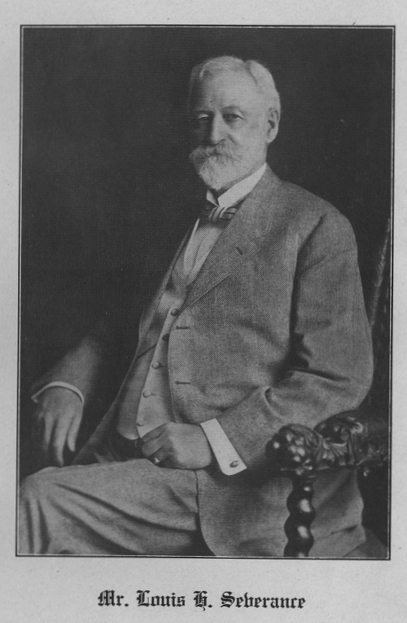
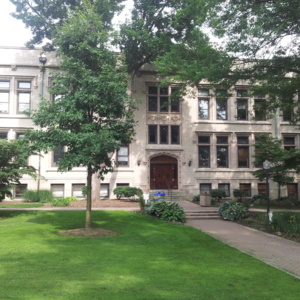
Citations
1 “Flames Work Destruction. The Outlook Encouraging,” The Wooster Voice, December 14, 1901, Vol. XXI, No. 14.
2 Ibid.
3 Ibid.
4 Louis E. Holden, Autobiography, 1926, Presidents Box 4, College of Wooster Special Collections.
5 “Flames Work Destruction. The Outlook Encouraging,” The Wooster Voice, December 14, 1901, Vol. XXI, No. 14.
6 Lawrence H. Officer and Samuel H. Williamson, “Seven Ways to Compare the Relative Value of a U.S. Dollar Amount, 1774 to present,” MeasuringWorth, accessed June 20, 2013, http://www.measuringworth.com/us/compare.
7 “Wooster and Wayne to the Rescue- $100,000 Promised for University Building If $40,000 Be Raised In Wooster and Wayne Co.- Citizens Should Rally to the Help of the University- New Subscriptions Received,” Wayne County Herald, January 2, 1902, Vol. XXIV, No. 1, Whole No. 1243.
8 “H.C. Frick Proffer- Willing to Donate Goodly Sum Toward Rebuilding of Wooster University, Destroyed by Fire,” Wayne County Herald, January 9, 1902, Vol. XXIV, No. 2, Whole No. 1244, taken from The Pittsburgh Times, January 1, 1902.
9 Louis E. Holden, Autobiography, 1926, Presidents Box 4, College of Wooster Special Collections.
10 Nicole C. Cook, “The Ressurection and the Life: The Importance of Louis Severance on the University of Wooster, 1901-1913” (College of Wooster Independent Study, 2000), 12.
11 Lucy Lillian Notestein, Wooster of the Middle West, (Kent: Kent State University Press, 1971) Vol 2., 83.
12 Louis E. Holden, “Eulogy remarks at the funeral of Louis H. Severance,” (June 28, 1913), Severance Family Papers, 1826-1989. Western Reserve Historical Society, Cleveland, Ohio.
How to cite this page:
MLA: “1901 Old Main Fire.” stories.woosterhistory.org, http://stories.woosterhistory.org/1901-old-main-fire/. Accessed [today’s date].
Chicago: “1901 Old Main Fire.” stories.woosterhistory.org. http://stories.woosterhistory.org/1901-old-main-fire/. (accessed [today’s date).
APA: (Year, Month Date). 1901 Old Main Fire. stories.woosterhistory.org. http://stories.woosterhistory.org/1901-old-main-fire/

